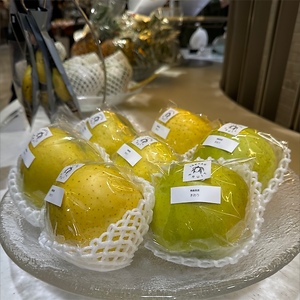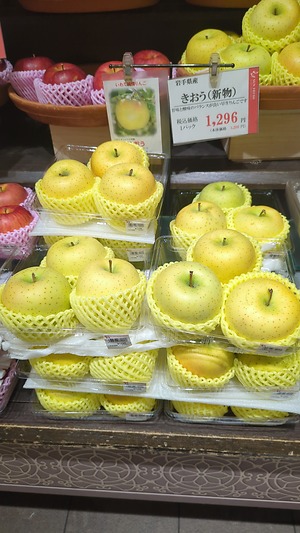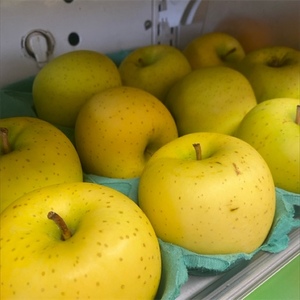


Kiou Apples
Estimated Inventory, lb : 0
Description/Taste
Kiou apples are medium to large in size, averaging 300 to 400 grams in weight, and have a round, conic, to cordate shape with flat shoulders, a broad, curved center, and a narrow base. The variety has smooth, taut, and sticky skin with a faintly glossy nature and ripens from green to yellow-green or golden yellow. Early in the season, Kiou apples are commonly yellow-green, and as the season continues, the apples develop golden yellow hues. The skin may also showcase a light bloom and prominent raised russetted lenticels, giving the surface a textured, semi-rough feel. On some fruits directly exposed to the sun for extended periods during cultivation, a subtle red blush is washed over the surface. Underneath the surface, the white to ivory flesh is aqueous, firm, dense, and coarse, with a crisp, succulent, and crunchy consistency. The flesh also encases a small central core filled with tiny black-brown seeds. When ripe, Kiou apples release a fruity aroma and should feel heavy for their size, indicating juice content in the flesh. The apples have moderate sugar and acidity, creating a balanced, refreshing, and rich taste with sweet, sour, and tangy nuances.
Seasons/Availability
Kiou apples are harvested in the late summer through fall, with a peak season in September through mid-October.
Current Facts
Kiou apples, botanically classified as Malus domestica, are a Japanese variety belonging to the Rosaceae family. The early-maturing cultivar was developed in the Iwate Prefecture in the late 20th century and was selected as a new commercial variety for its crisp, juicy texture, sweet taste, and golden coloring. Kiou apples are a rare variety in Japan, only found for a short season. The apples are grown in limited quantities and are harvested at peak ripeness to ensure the fruits have a balanced, sweet, and tart flavor. Kiou apples grow on vigorous trees, and the variety is primarily sold in retail markets as a fresh-eating cultivar in the fall. When in season, Kiou apples have a rich, sweet, and tangy flavor and are favored as a specialty apple throughout Japan, utilized in an array of sweet or savory preparations.
Nutritional Value
Kiou apples are a source of magnesium to control nerve functions, fiber to regulate the digestive tract, potassium to balance fluid levels within the body, and calcium to build strong bones and teeth. The variety also provides vitamin C to boost the immune system, vitamin A to maintain healthy organ functioning, copper to develop connective tissues, and other nutrients, including zinc, vitamin E, iron, vitamin K, folate, and boron.
Applications
Kiou apples have a sweet and tangy taste suited for fresh and cooked preparations. The variety is typically consumed out of hand, savored for its juicy, crisp flesh and refreshing nature, and the skin can be eaten or discarded, depending on preference. Kiou apples can also be shredded into coleslaws, chopped and dressed in potato salads, or sliced into green salads. The apple’s crunchiness adds texture to fresh spring rolls and sandwiches, or wedges of the fruit can be served on charcuterie plates as a complement to cheeses, nuts, and dried fruits. Kiou apples can also be blended into smoothies, shakes, and fruit juices. In Japan, Kiou apples are often simmered into jams, jellies, syrups, and compotes. The apples are occasionally incorporated into cooked preparations and develop a flavorful sauce that can be served with roasted meats. Kiou apples can also be boiled in sweet sugar water as a dessert, stewed in caramel and topped over toast with vanilla ice cream, or used as a roasted garnish over pancakes and waffles. Try incorporating Kiou apples into pies, tarts, muffins, and bread recipes. Kiou apples pair well with spices such as cinnamon, ginger, cloves, and nutmeg, nuts including almonds, walnuts, and pecans, and other fruits such as blackberries, blueberries, grapes, and melons. Whole, unwashed Kiou apples will keep for 1 to 3 weeks when stored at room temperature in a cool, dry, and dark location. The variety will also last up to one month when wrapped in newspaper, placed in a plastic bag, and kept in the refrigerator’s crisper drawers.
Ethnic/Cultural Info
Kiou apples were named for their regal, shiny, and golden yellow coloring. The variety’s name translates from Japanese to mean “The King of Yellow Apples” or “Yellow King Apple.” Yellow apples are increasing in notoriety in Japanese markets as the color often signifies a “cheerful or bright” nature. Traditionally, red has been a symbolic color within Japanese culture, leading red apples to dominate the market. In the modern day, growers are expanding beyond the customary varieties to grow yellow apple varieties to symbolize happiness. The word “ki” in Kanji also means “yellow” and “happiness,” causing consumers to label Kiou apples as the “happy apple.” The apples are also compared to Japanese pears, and the cultivar’s flesh texture is crisp, coarse, and juicy, similar to the consistency of Asian pears.
Geography/History
Kiou apples are native to Japan and were developed through the Iwate Prefectural Horticultural Experiment Station, now known as the Iwate Prefectural Agricultural Research Center in Kitakami City. The variety was created from a cross between Orin and Chiaki apples in 1983. It is important to note that records originally state that the cultivar was developed from an Orin and Hatsuaki apple parentage, but genetic analysis conducted at a later date determined the parentage was, in fact, Orin and Chiaki. Seeds from the initial cross were planted in 1984, and several years later, seedlings were selected for evaluation and propagation based on specific growth characteristics. The variety was filed for registration in 1991 and was known as Iwate No. 1 apples. It was granted registration in 1994 and was released as a new commercial cultivar in Japan under the name Kiou. Today, Kiou apples are a rare variety grown in limited quantities in Japan. The variety is also only available for a short season, making the apples a specialty fruit in the fall. Kiou apples are primarily cultivated in the Aomori Prefecture, accounting for around 70% of total production, followed by the Iwate Prefecture at 29% and the Hokkaido Prefecture at 1%. Outside Japan, Kiou apples are mostly planted as a novelty in a few orchards throughout North America.










